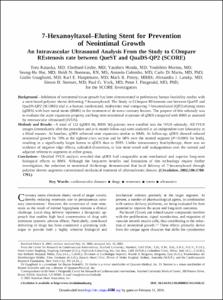KUMEL Repository
1. Journal Papers (연구논문)
1. School of Medicine (의과대학)
Dept. of Internal Medicine (내과학)
7-Hexanoyltaxol–Eluting Stent for Prevention of Neointimal Growth An Intravascular Ultrasound Analysis From the Study to Compare REstenosis rate between QueST and QuaDS-QP2 (SCORE)
- Keimyung Author(s)
- Hur, Seung Ho
- Department
- Dept. of Internal Medicine (내과학)
- Journal Title
- Circulation
- Issued Date
- 2002
- Volume
- 106
- Issue
- 14
- Abstract
- Background— Inhibition of neointimal tissue growth has been demonstrated in preliminary human feasibility studies with a stent-based polymer sleeve delivering 7-hexanoyltaxol. The Study to COmpare REstenosis rate between QueST and QuaDS-QP2 (SCORE) trial is a human, randomized, multicenter trial comparing 7-hexanoyltaxol (QP2)-eluting stents (qDES) with bare metal stents (BMS) in the treatment of de novo coronary lesions. The purpose of this substudy was to evaluate the acute expansion property and long-term neointimal responses of qDES compared with BMS as assessed by intravascular ultrasound (IVUS).
Methods and Results— A total of 122 (qDES 66, BMS 56) patients were enrolled into the IVUS substudy. All IVUS images (immediately after the procedure and at 6-month follow-up) were analyzed at an independent core laboratory in a blind manner. At baseline, qDES achieved stent expansion similar to BMS. At follow-up, qDES showed reduced neointimal growth by 70% at the tightest cross section and by 68% over the stented segment (P<0.0001 for both), resulting in a significantly larger lumen in qDES than in BMS. Unlike intracoronary brachytherapy, there was no evidence of negative edge effects, unhealed dissections, or late stent-vessel wall malapposition over the stented and adjacent references segments in either group.
Conclusions— Detailed IVUS analysis revealed that qDES had comparable acute mechanical and superior long-term biological effects to BMS. Although the long-term benefits and limitations of this technology require further investigation, the reduction in neointimal thickenings demonstrated that local delivery of 7-hexanoyltaxol through polymer sleeves augments conventional mechanical treatment of atherosclerotic disease.
Key Words: cardiovascular diseases
drugs
restenosis
stents
ultrasonics
- Keimyung Author(s)(Kor)
- 허승호
- Publisher
- School of Medicine
- Citation
- Toru Kataoka et al. (2002). 7-Hexanoyltaxol–Eluting Stent for Prevention of Neointimal Growth An Intravascular Ultrasound Analysis From the Study to Compare REstenosis rate between QueST and QuaDS-QP2 (SCORE). Circulation, 106(14), 1788–1793. doi: 10.1161/01.CIR.0000031734.11420.1C
- Type
- Article
- ISSN
- 0009-7322
- Appears in Collections:
- 1. School of Medicine (의과대학) > Dept. of Internal Medicine (내과학)
- 파일 목록
-
-
Download
 oak-aaa-00954.pdf
기타 데이터 / 438.66 kB / Adobe PDF
oak-aaa-00954.pdf
기타 데이터 / 438.66 kB / Adobe PDF
-
Items in Repository are protected by copyright, with all rights reserved, unless otherwise indicated.